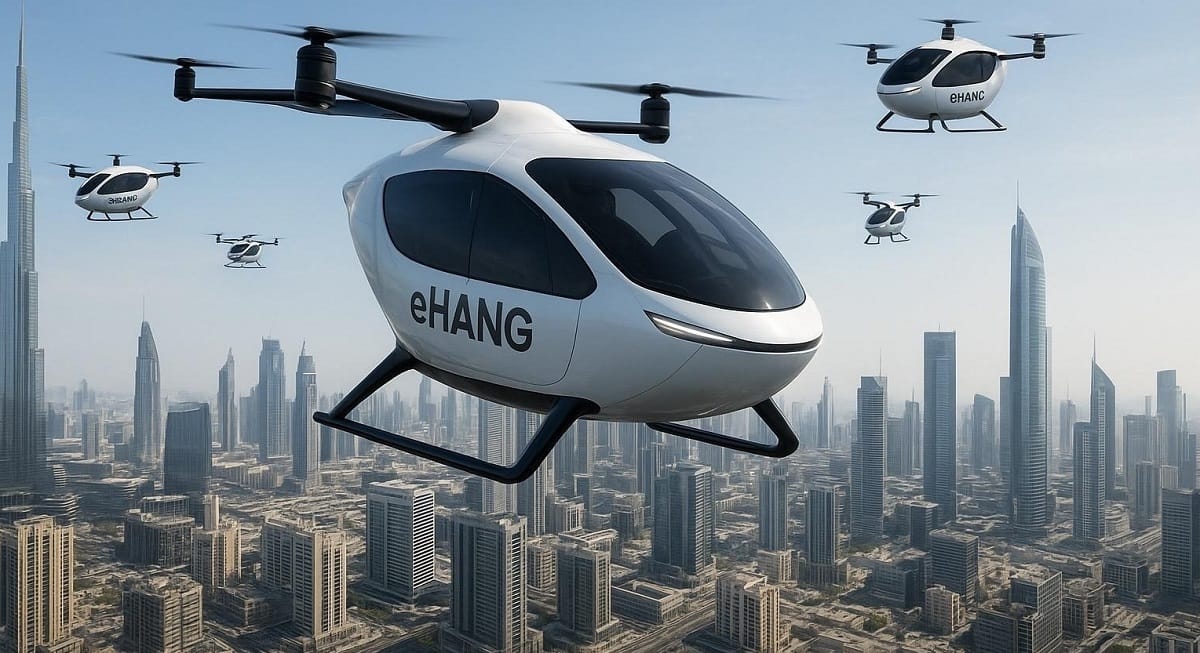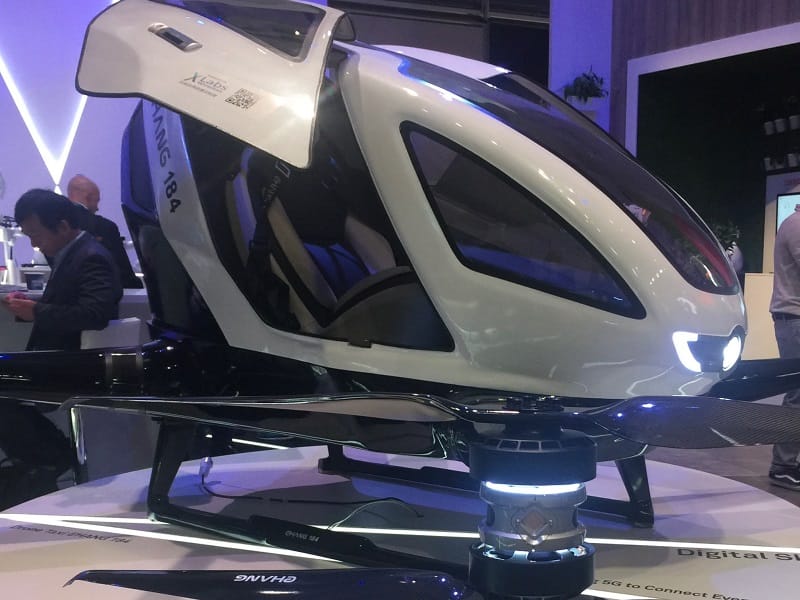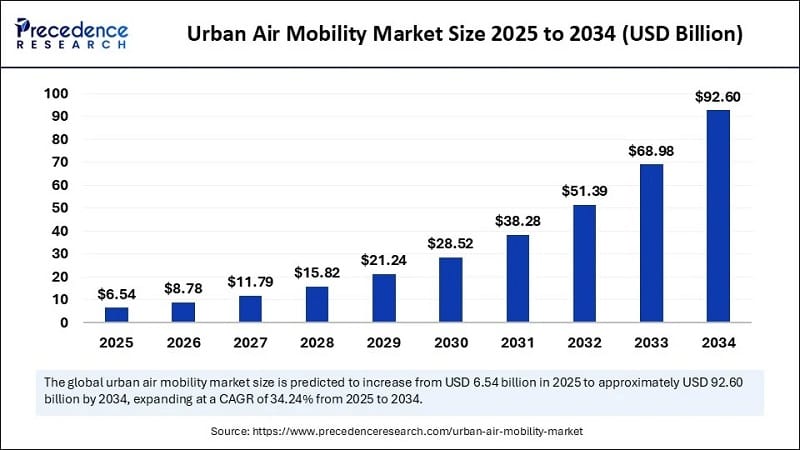
The future of flying vehicles is closer than you think
Self-flying air taxis could be mainstream as soon as 2030.
Self-flying, fully electric air taxis are no longer a promise for the distant future. Within the next five years, anyone will be able to take an air taxi ride, booking and paying through an app like we do with Uber today, as long as the service is available in their city.
In 2018, EHang, an autonomous aerial vehicle (AAV) technology company based in Guangzhou, China, exhibited its EHang 184 prototype at MWC (Mobile World Congress) in Barcelona (see photo below). The EHang prototype demonstrated its vision for a future where flying taxis will be used for urban air mobility, reducing commuting time and shortening distances. The company also anticipated the use of flying vehicles to deliver medical supplies, organs for transplant, and emergency services in remote areas where access by road is impossible or difficult.
This future looked promising, but rather distant. The EHang air taxis were going to use 5G networks to transform cities into smart cities. That was the most exciting thing about the urban air mobility promise; 5G networks were the number one hot topic back then. At the same time, electric vehicle companies were making progress, with car manufacturers proudly demonstrating their vehicles at the MWC conference. Those of us who were there, attendees and members of the press, were able to jump onto fully autonomous, self-driven minivan rides within a restricted test area in Barcelona. The future of urban mobility experience felt like science fiction. Regulation and certification were the main reasons slowing things down.
Now, seven years later, the promise of unmanned flying vehicles has become a reality. Thanks to developments in various technologies, including 5G networks, sensors, and artificial intelligence, and the first certifications granted in China, fully autonomous air taxis have moved from the exhibition floor to the open sky above selected cities.
Today, EHang develops and manufactures autonomous aerial vehicles (AAVs), carrying up to two passengers, which have already entered service in China for aerial cinematography, photography, emergency response, and survey missions.

The future of urban on-demand air mobility
The global Urban Air Mobility (UAM) market size accounted for $6.54 billion in 2025 and is forecast to reach $92 billion by 2034, according to a September 2025 report by Precedence Research. The study indicates that intracity travel is the fastest growing range during the forecast period. Artificial intelligence is playing a central role by enhancing safety, efficiency, and scalability.
In the coming years, more platforms, infrastructure, services such as vertiports, and autonomous options will expand further. The number of different UAM platforms (vehicles) is also forecast to increase over the same period.

Asia Pacific is the fastest-growing region in the urban air mobility sector. Due to rapid urbanization and increasing demand for innovative mobility solutions, governments in the region are actively supporting the development of the industry through policy initiatives, infrastructure planning, and partnerships with global aerospace leaders. The Asia Pacific region is thus emerging as the next powerhouse for market adoption.
In 2023, AeroTime reported that EHang was the world’s first to obtain certification from the Civil Aviation Administration of China (CAAC) for its human-carrying, autonomous EH216-S aerial vehicle, which clears a path for operations in Chinese cities over the next three to five years. EHang leads a growing group of Chinese companies developing flying taxis, including XPeng, AeroHT, TCab Tech, and Volant Aerotech.
The certification acts as a benchmark for more efficient and wide-scale airworthiness certification for aircraft of this kind in China and other countries. Initially, the operations include limited settings, tourism, and set routes that may include airports, but this is rapidly expanding.
In September, Rwanda, in partnership with EHang, achieved the first public self-flying, human-carrying electric air taxi EH216-S flight in Africa, at the 9th Aviation Africa 2025 Summit in Kigali. The aircraft can fly from Kigali to the airport in five minutes, instead of the normal 45-minute drive. As for safety features, it has automatic emergency landing and electric distributed propulsion—which means that if one motor fails, there are another fifteen motors keeping the aircraft in the air. The battery takes one hour to fully charge. Rwanda has the most progressive aviation regulations in the world, and China chose Rwanda as a partner for this reason.
Rwanda has permissions, certifications, and regulations already in place for this type of self-flying air taxis. Since 2016, Rwanda has been using drones for deliveries and for transporting medical supplies, including vaccines and donor blood, to remote villages.
Commercialization by other players is also advancing fast. Hyundai’s Supernal plans on launching a 5-seat eVTOL (electric vertical take-off and landing) aircraft for passenger travel by 2028. Other companies, like Joby Aviation, also see 2026 as a key year for commercial service in certain jurisdictions, assuming regulatory certification proceeds as planned.
In order to go from pilot projects to mainstream adoption, there are still some challenges that need to be addressed. Mainstream adoption will mean there are frequent, reliable, cost-effective and competitive autonomous/self-flying air taxis in many cities.
First, will people trust self-flying vehicles when many are still reluctant to accept self-driving cars? How will ticket prices compare to ground transport?
Certification and regulation require high safety standards, as discussed above. The important considerations include piloted versus autonomous operations, type certification, and airspace rules, especially for urban and low-altitude flight.
Cities must develop, plan, and improve their infrastructure, building multiple vertiports, installing charging/battery swapping facilities, and putting in place maintenance crews, ground control, and air traffic management integrated with current transport systems.
Both cities and companies offering self-flying air taxis must consider technology limitations on battery range, weight, and charging. This is one reason existing self-flying air taxis in China today only complete short journeys. Autonomous control systems need to be carefully planned for collision avoidance and navigation in urban canyons. These vehicles are developed with special noise reduction features, but safety in all weather conditions needs to be addressed, too.
Self-flying air taxis becoming mainstream
After following self-flying air taxi developments for almost a decade, this is what I think about the race of flying vehicles towards becoming mainstream.
By 2028-2030, several cities in Asia, China, parts of Africa, and the Middle East will have regular air taxi/eVTOL service offerings. Some will feature some fully autonomous features but still often with pilots or remote oversight.
By 2030-2035, for urban journeys including airport to city and city-to-city short hops, fully autonomous air taxis or with minimal human pilot intervention will be an accepted option in several parts of the world. This will likely be in cities with good infrastructure and supportive regulation.
Widespread mainstream use, meaning that many people use them as a regular commuting alternative and priced affordably will heavily depend on cost, regulation, and safety; so, perhaps more toward the mid-2030s onward, we can expect to see self-flying air taxis mainstream everywhere.
